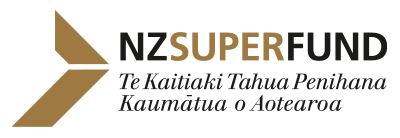Media statements
NZ Super Fund up by $4 billion to finish the financial year at $39 billion; has returned 10.4% p.a. since inception
POSTED ON: 28 September 2018
Share:
The NZ Super Fund finished the 2017/18 financial year at $39 billion, up $4 billion during a year which was notable for the resumption of contributions to the Fund in December 2017, after an eight year suspension.
Chair Catherine Savage said both broad markets and the NZ Super Fund had performed well during the year, with global equities rising in value and the NZ Super Fund beating its Reference Portfolio benchmark.
The Fund returned 12.43% (after costs, before NZ tax), beating its passive Reference Portfolio market benchmark by 2.02% ($700 million). It exceeded the average return on Treasury Bills, its other benchmark, by 10.71% ($3.7 billion).
“While 2017/18 has been an excellent period for the NZ Super Fund and it is good to acknowledge a strong annual performance, the Board continues to take a long-term view,” said Ms Savage. “In the context of a Fund that will not begin to experience sustained withdrawals until the 2050s, it is important not to put too much weight on short term performance. We are managing the Fund for our children and our children’s children. This inter-generational purpose is key to all our investment decision-making.”
This year’s result brings the Fund’s returns since its inception in 2003 to 10.4% per annum, and value added versus the Reference Portfolio to 1.49% - a total of $7.6 billion.
Commenting on the reasons the Fund exceeded the Reference Portfolio benchmark, CEO Matt Whineray pointed to three areas: strategic tilting, in which the Fund’s exposure to different asset classes is adjusted over time; timber, primarily its 42% stake in Kaingaroa Timberlands; and an internally-managed credit mandate.
“These active investments (as with all of our active investment strategies) are designed to play out beyond annual cycles and are carefully chosen to take advantage of the Fund’s endowments as an investor – our long term horizon, known liquidity profile, sovereign status and operational independence. Tilting, timber and our internal credit mandate have consistently added value to the Fund over a number of years: pleasingly, the strong performances in 2017/18 are not one-offs.”
Mr Whineray said that efficient implementation was also a factor in the Fund’s strong performance and noted that the cost of managing the Fund, as a percentage of net assets, had declined to 0.28% compared to 0.35% in 2017 and 0.44% five years ago. “We continue to have a strong focus on cost control and ensuring we get value for money in all our investments and activities.”
“Looking ahead, the external environment appears challenging. Global growth is beginning to decelerate, inflation is starting to rise in some developed markets, and financial conditions are tightening with the withdrawal of central bank liquidity. While trade tensions have been escalating, the contagion into financial markets has been limited to date.”
“While the Fund remains heavily weighted towards growth assets such as shares, with many markets at or above fair value, we have lowered the amount of active risk being taken. This is a measure of how different the Fund’s actual portfolio is from the passive Reference Portfolio – they have got closer during the year.”
“We are also maintaining higher than normal levels of liquidity in the portfolio - assets that can be sold easily to meet our obligations or to fund new investments. This will ensure the Fund can withstand any future market stress and take advantage of new investment opportunities as they arise. We remain committed to our long-term investment strategies and will continue to take a highly disciplined approach to active investment.”
The Government contributed $500 million to the Fund over the 2017/18 financial year. Monthly contributions increased to $89 million per month from July 2018 and are projected to increase to the level specified in the Fund’s governing legislation by 2022. Since inception in 2003, the Government has contributed $15.4 billion to the Fund and the Fund has paid $6.4 billion in NZ tax.
The Fund’s Annual Report will be tabled in Parliament in October.
